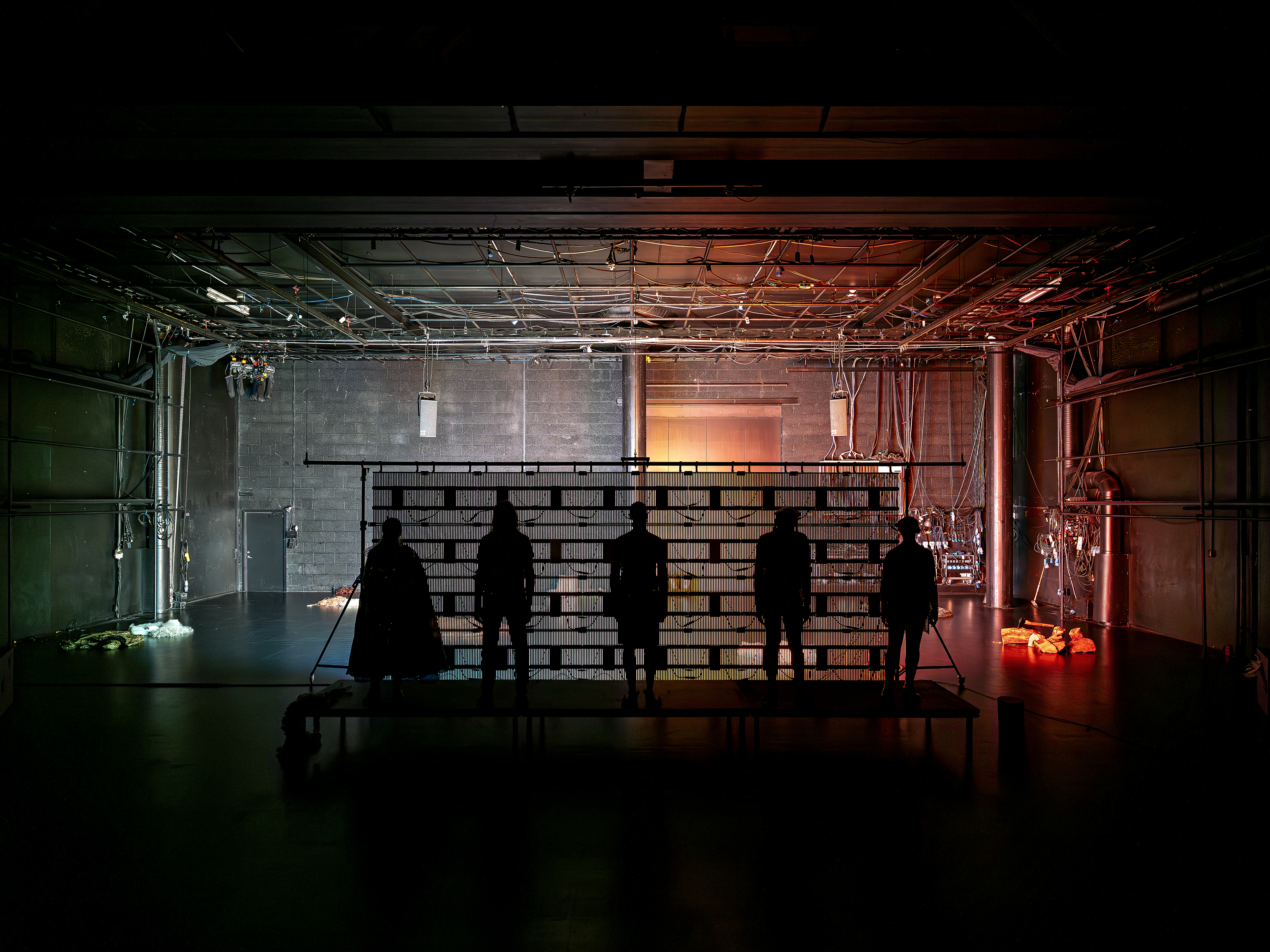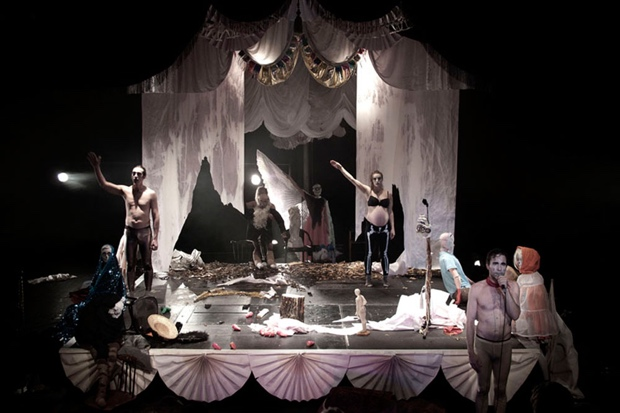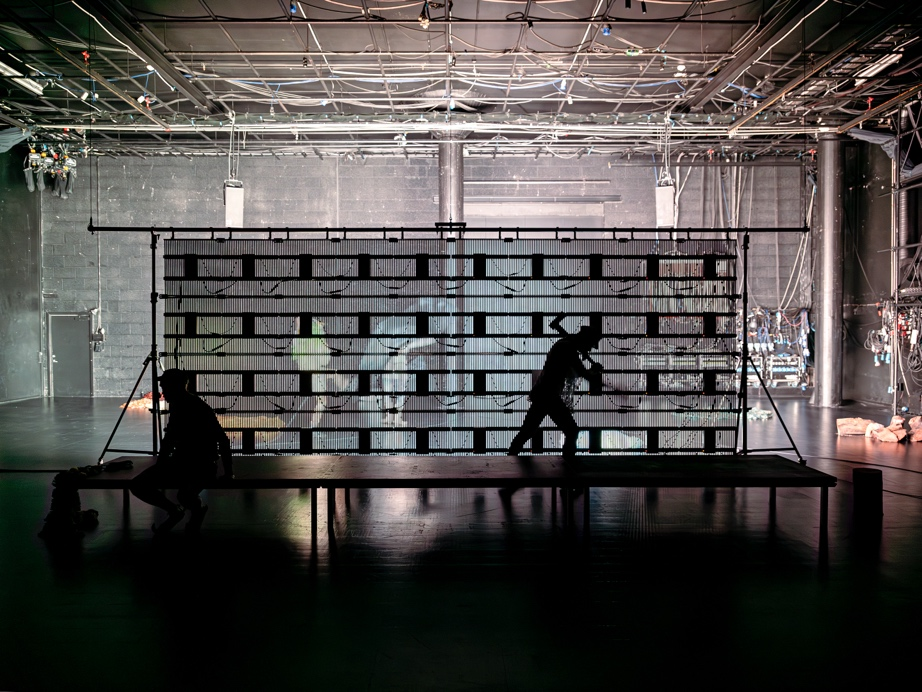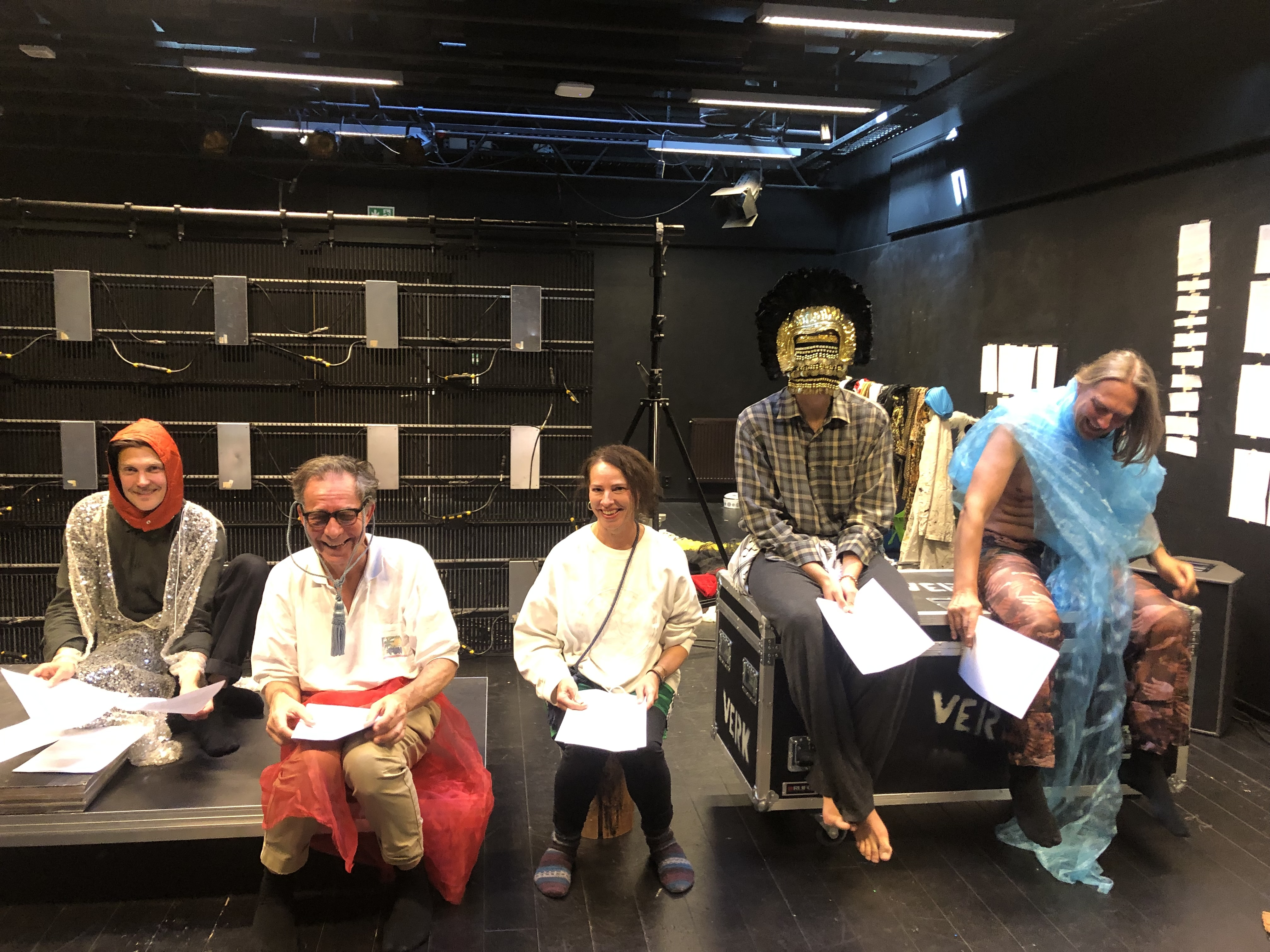
Solaris working document. Unfolding histories.
In a distant corner of the universe lies the planet Solaris. Its surface is covered by a mysterious, fluid substance that can take on the most incredible forms. This ocean has given rise to a myriad of theories about intelligent life, and for over a hundred years, scientists from Earth have attempted to solve the mystery of Solaris.
The psychologist Kelvin arrives at the research station on Solaris and quickly discovers that it is not just the regular crew on board. The station is haunted by beings that seem to originate from the crew’s memories. Kelvin himself is confronted by a lifelike copy of his deceased wife, Rheya. The Solaris ocean may be a massive brain that creates these incarnate memories, though its purpose in doing so is unknown, forcing the scientists to shift the focus of their quest and wonder if they can truly understand the universe without first understanding what lies within their hearts.
August 26. 2024 – Day 1 of the rehearsal period Solaris. (Link to daily summaries)
Actor A shared an incident from a session with his psychologist. The psychologist had asked him to describe their relationship and how he perceives the psychologist. In response, the psychologist challenged A’s assumptions, suggesting that these perceptions might be reflections of A himself—his own projections. Essentially, we can never fully define another person because each of us only has direct access to our own perspective.
I believe it was Actor B who commented that we’re always somewhere on a spectrum of psychosis.
Before the first rehearsal day, I had spent many months pondering, trying to find pathways into the material of Solaris. In my work with Verk, I rarely create a finished script from A to Z. However, as a personal challenge, I often attempt to write a script in the faint hope that this time, I might manage to create something so enchanting that everyone would immediately want to bring it to life.
Yet, as usual, I often loose interest in the script. It felt artificial and overly constructed, and I found myself drawn toward other doors of interest and inspiration. I began listening to short stories instead, letting them guide my thoughts.
Listening to short stories reminded me of a performance we created back in 2010, based on a novel by Pär Lagerkvist titled Det Eviga Leendet (link to our homepage The Eternal Smile). The novel is, in short, a depiction of different groups of dead people trapped in eternity, passing the time by sharing their life stories. These people, from various layers of society, recount their experiences, but after thousands of years, they come to see both the stories and the endlessness of eternity as utterly meaningless. This realization leads them to revolt, confronting God to demand the meaning behind it all.
At the time we were starting to question what is special about Theatre and wanted to in some way stage “The Theatre” in the Black Box and built up a multilayered old classical theatre scene in the black box representing the eternity but also showcasing the esthetics of an old theatre.
Pictures from The Eternal Smile:



Around three-quarters of the play consists solely of actors retelling stories from the book. It struck me as incredibly simple yet deeply intricate. Simple, in the sense that there was no direct drama between the actors or characters—they merely shared different life stories with each other and the audience. There was no conflict driving the action. But precisely because there was no conflict or defined characters, questions began to arise: Who are the actors in this context? Who is telling the stories? Where are we, as an audience, situated in this storytelling? How to play someone who is dead? Strangely, a fictional world began to emerge, and it did so in a remarkably intriguing way.

The actors shifted fluidly between different roles of storytelling: moving in and out of the fictional world which was losely sitting in the eternity/theatre, transitioning from storytellers narrating what they were about to do, to performing those moments within the fiction itself. They were simultaneously present and direct, engaging with the audience in the “here and now,” while seamlessly diving into a scene and embodying it. This interplay between storytelling and performance created a dynamic, layered experience that blurred the lines between reality and fiction. This work was an important revelation—both in its mode of storytelling, discovering alternative ways to re-present a character(both in and out), and in its framing of eternity, which is as incomprehensible as theatre itself, framing it as Theatre itself.
Back to Solaris. When I began listening to short stories, it brought to mind our performance The Eternal Smile. But it also reminded me of another work that had inspired us at the time: Forced Entertainment’s And on the Thousandth Night(2000), a durational performance where stories are told continuously for eight hours.
In And on the Thousandth Night, the performers interrupt, exaggerate, and take over each other’s narratives, creating a dynamic and layered storytelling experience. This approach resonated deeply with me, as it blurred the boundaries between structure and chaos, between individual voices and collective storytelling. It was a source of inspiration that lingered with me, particularly as I explored the narrative possibilities within Solaris.
For a long time, I immersed myself in listening to short stories. Together with two of my close companions, Saila and Anders, we began writing small short stories and anecdotes of our own. Even at that stage, my interest in stories that, in some way, questioned the nature of theatre itself had already started to take shape. However, I remained unsure and deliberately kept the process open. (Link to the stories we wrote at the time) Example:
Once upon a time, there was a zombie who no longer wanted to live the typical zombie life. He decided he wanted to become an actor because that way, he could play living humans, and no one would realize he was a zombie. So, he disguised himself as a living person and managed to get into drama school. The entrance audition was tough, but he quickly realized that his greatest strength was portraying humans in a slightly zombie-like manner—deadpan, expressionless—and he found great success with this interpretation of Hamlet.The problem arose when he started taking Stanislavski classes at school, where actors are trained to immerse themselves in human psychological situations. That, of course, was completely beyond his capabilities.
One could ask: where the hell is Solaris in all this? The truth is, Solaris has seemingly faded into the background—perhaps becoming a backstory, or perhaps not even that. Yet, throughout this process, I had a persistent sense that the backbone of the Solaris story remained with us. There’s a lovely quote in Solaris: “The only thing our instruments were able to pick up (from Solaris) were random fragments of an eternal, colossal monologue that went beyond our comprehension.” That inspired me to envision a vast, ongoing, fragmented monologue on stage reflecting how our memories and the stories that define us are always connected to something—fragments of meaning, like the bits and pieces of the enormous monologue in Solaris. In this way, the theatre itself becomes Solaris, and the actors transform into Rheyas, the phantoms, the mirrors onto which the audience projects their emotions, their memories, and their own inner landscapes. The audience, in turn, could remind us of Kelvin—struggling to make sense of the events unfolding as he arrives at the station, grappling with the unknown and the reflections it stirs within.
The Space. Thinking-Scenography
While exploring possible pathways into Solaris, I also held meetings with our scenographer, who has been working with us since 2019. These sessions were spaces for mutual exchange, where I shared insights and ideas about this ongoing monologue, and he, in turn, shared his own impressions and thoughts. We carefully responded to each other’s ideas, creating a dialogue that allowed us to observe what resonated and inspired us both.
Before long, we became convinced that the room—the space itself—needed to connect more intimately to the framing of Solaris. I remember he was particularly drawn to the idea that Solaris had two suns, one red and one blue. He suggested that this duality might be the underlying cause of the strange and unsettling phenomena on the planet.
We also discussed recycling materials from previous performances, which, in turn, is also a recycling of our previous ideas from our last performances we have made together. Our scenographer has been particularly interested in repurposing our displaced props and costumes stored in various locations.
These ideas align with larger conversations we’ve had within our group, dating back to our performance Build Me A Mountain (2011). That work was deeply inspired by archival art, which seeks to make historical information—often lost or displaced—physically present.
Having had the privilege of working for so many years, I’ve begun to view our past performances as an archive, one that is both tangible and intangible, yet often fragmented or displaced. The tangible elements—scenography, props, and costumes—are scattered across storages on the outskirts of Oslo. But equally important are the intangible aspects: choreographies, memories, ideas, and even creative cul-de-sacs. These, too, form part of an archive that has, over time, been forgotten or displaced.
It is an immense body of work, yet only fragments of it remain accessible to us today. In this way, cultural artifacts themselves, such as the film Solaris, can also be seen as fragments of information—pieces of a larger whole that invite us to uncover, interpret, and reimagine their significance.
Here is a fragment from my application to the Norwegian Arts Counsil from 2020:
We often imagine ourselves as archaeologists, unearthing fragments and
broken pieces of information. We search and discover this film amidst
the rubbish heap of history. This creates a fitting distance from the
material. We find an object created by humans—an artifact, a work of
art—that we use to analyze and document human activity. Everything it
references and suggests is examined with equal intensity and curiosity.
In this artifact we are investigating, we uncover lines and references to other findings: films, stories, themes, and parallel events. We use the film/artifact as a tool to decode and understand ourselves. We engage with it, draw conclusions, and create new connections in our own lives.
One method for approaching cultural memory is to attempt to recreate, from memory, the thoughts and impressions the film evokes. This memory can be regarded as fragments of a cultural identity and understanding.
Our archaeological project will consist of cataloging, evoking, and documenting cultural identity while creating new connections. This includes retelling, recreating, and reconstructing events and occurrences within our own collective memory.
He also suggested to use a LED screen, that we used in our previous performance, but turning it around so that the audience only saw the reflections of light.

The collective. Thinking-making together.
At this stage of the process, all the participants gather around the table in the workspace—this time, a modest loft at KHIO in Oslo. Since I haven’t managed to create a script, I begin by sharing my inspirations.
We are a group of individuals with a rich history of collaboration. Three of us have been working together since 1993, one since 2003, another two since 2006, and the remaining two since 2017. These layers of shared experiences create a unique dynamic, blending long-term partnerships with newer perspectives. These experiences we have together can also be seen as a collective archive with an immense power of morphogenesis.
As we can see, some decision making has already taken place—particularly regarding the space we will inhabit (the stage) and various textual starting points and references. However, no major decisions have been made yet about the script, characters, or how we will use the Solaris material. Instead, we are gathering all the material in the room: actors, questions, inspirations, the Solaris novel, films, references, pieces of scenography, and bits of old costumes from previous performances. In a way, this is our playroom. We have decided on some elements to experiment with, but we remain open to new ideas.
At this stage, the collaboration is less hierarchical and more horizontally organized, allowing a multitude of voices to emerge and the collective to take over. We engage in reading key excerpts from the novel, storytelling improvisations (with some pre-set rules), discussions about the current political situation, composition try-outs, chorographies and explorations of what Solaris has to do with it all.
When we tire of sitting around the table, we move to the “floor” and collectively agree on some compositional try-outs, usually incorporating physical limitations. This is a playroom where thinking and making merge, where participants respond to the material at hand by formulating thoughts and ideas through the very practice of theatre— and through composition. Afterwards, we discuss the work we have just created and consider how we might elaborate and develop it further.
In the Solaris process, we began reusing all our choreographies from previous performances, ultimately creating one long piece based on four different performances. Why? Because it made sense. In Solaris, Kelvin revisits his past; in Verk, we revisit our past choreographies. Simple as that. This is not the place for lengthy critical debates on why this or that should be done—it is our playroom, our free space, or, as Deleuze might say, our escape routes from judgment (division, categorization, selection, correctness, decision). There is no reason other than the need for change—to move, explore with our bodies, and express something. This is a space devoid of judgment because we don’t yet know what to judge it against. It is beautiful because watching bodies attempt to solve a concrete task in space is, in itself, beautiful; it carries a pre-expressive sense. Sense emerges from the task itself, and every body attempting to solve a concrete challenge is unique, personal, and profoundly moving—because you expose not only your body but also your inner self. This is also the place where the actors start integrating costumes and props. Slowly but sureley they sip into the improvisations/compositions. It is also here we explore and interact with the space or playground we have created.
Solaris, from the rehearsal period incorporating choreographies:
An important aspect of this playroom is my use of sound and music. I’ve built up an extensive playlist over many years—both from my own work and in collaboration with our musician, Per Platou—which I employ in these compositional improvisations. I can’t overstate how vital this is to our process. It propels us out of our daily routines and towards ecstasy and forgetfulness—a space where we abandon self-consciousness and the confines of our thoughts. In this environment we allow our bodies to take control, our instincts to lead, and push ourselves towards our expressive limits.



In this chaotic, fertile, and horizontally organized environment, we explore, experiment, and assemble small blocks of intensity, laying the foundation for our performance—while remaining attuned to loopholes, those unexpected cracks where something new may arise.This space is crucial because it allows us to accumulate a diverse range of materials, each carrying varying degrees of sense. Over time, it becomes our bank of material—a vault from which we can draw resources at moments of creative block or uncertainty. These accumulated fragments often come to our aid, offering solutions when we least expect them. Interestingly, many of these early improvisations or compositions already contain the essential elements of the performance. Often, these first initial responses follow us all the way through the process and becomes a key scene in the performance.
As the director, I remain on the lookout for starting points and critical thresholds. Professor and experimental filmmaker Manuel DeLanda, drawing on Deleuze´s ideas, describes these thresholds as moments of morphogenetic (form-generating) change—like water turning into gas at 100°C. I watch for moments when something accumulates, when a sudden sense emerges, when I feel moved; when connections begin to form, small sparks of energy that transforms. One might say these moments are pre-cognitive intensities—forces that affect us.They can be sudden flashes of understanding, revealing previously unseen connections between texts, actions, movements, images, sounds, costumes, people, things, and more. Often, these breakthroughs arise after periods of artistic struggle, instantly unifying everyone in the room in a shared recognition that something significant has happened. They are typically pre-cognitive, because at that moment, we don’t fully grasp what they are—a comprehension that surpasses our immediate cognitive awareness. These are artistical leaps of understanding revealing a new logic that emerges in the space.
Rather than analyzing these sudden insights, we nurture them, valuing their pre-cognitive power to reshape the work. It is a constant struggle to restrain identifying and analyzing what this moment is and shifting the focus to what it can become, tapping into its virtual potential. These “critical thresholds” become our primary building blocks of the performance rather than relying on traditional interpretative methods.
(Questions to myself: Ok, this is an important aspect of my work that I have to elaborate on. What do I mean when I say traditional interpretative methods? And why is it so important to restrain labelling or analyzing what that critical threshold is? And what is “virtual potential”? Another point of discussion is concretly how do I arrive at these moments, or what building blocks do I use to arrive at these moments. What guides me in my making of a performance? Could it be that in exposing my guidelines, showing them, talking about them, sharing them to the audience could be a way to work with “The Tempest”, grounding the work in Prosperos books, Fredriks books, and putting in the tempest into that.)
September 19. 2024 - Day 19 of the rehearsal period Solaris Discussion on the further direction of the script. That we need to bring out these “spaces of freedom” that no one can buy and no one can pay for. What exists “on the other side” – that’s what Solaris is about – is stated.
The culture that is being shortened, cut off, choked, killed, but what about everything that cannot be measured! “That other space” that is being closed down – is it being abolished, condemned? Is it worthless? What is its value? Where is the value, and in what way should that which cannot be measured be measured? What happens when we suddenly find ourselves in competition for money, and all the money should really be used for defense? Because the world is at war??? Or?
Our theater is also a political expression, even though the expression itself cannot be described as a stated statement, or in a program declaration; the political perhaps lies in the insistence on holding on to that which is ineffable (undescribable), holding on to that which can sometimes be experienced even more real than reality. Something along those lines. Around two o’clock we conclude our joint day, and once again the script team sits down and tries to find texts that can express something about the things we care about—how to express without being too preachy, too specific, too wordy, hinting, issuing commandments, shaping without using power, perhaps pondering, sparking wonder, giving room for personal interpretation, giving the feeling of finding one’s inner story, or one’s own logic that can say something about being human in the world.
Well, well, well. At the same time, it must not become too cryptic either, because after all it’s about something, and this something is there in the book, in the films, in our encounter with that material, and between us—in all the thinking, confusion, and discussions. The terrible hour of wonder is not over yet. Have a nice day, after all. We are getting closer regardless. It is inevitable. Thank you for today. S

Maximising Perception: Unveiling the Virtual in Theatre
Dogs understand so much, yet they cannot express it—or they express it with their dog eyes. In that way, it resembles good art, which can never truly express its meaning; it can only say something else and remain silent about what it really wants to say. Thus, art, faith, and a dog’s silent understanding are one and the same. Jon Fosse Septologien
Art has the power to transform our perception. In everyday life, we filter what we see through our past experiences—allowing us to recognize familiar elements, like the color red. In art and theatre, however, we have the opportunity to expand our vision and anticipate what isn’t yet present, but is still real. The present carries a virtual space that we gradually uncover in fleeting glimpses. Once something appears on stage, it transcends its physical form, bearing a virtual aura of absence that remains no less real. A simple chair can evoke an entire kingdom; an ordinary text can become profoundly significant; and a gesture—or even a subtle turn of the head—can reveal an entire world.
The text and the actors are an interface—a point of contact I use to transport the audience into new, unknown territories through finely tuned tensions in the space. It’s a contact surface that guides the audience and enables the various elements to merge. I don’t know exactly what I’m searching for when I try to create room for something unknown to emerge, but I sense it when something begins to dawn and resonate in the space. The text stops being just text. The set design ceases to be set design. The body is no longer merely a body but becomes something else—a sign, a symbol, an unknown language. It’s as if the boundaries of things become porous, opening up unforeseen entrances and possibilities. The interface is recognizable and safe, creating identification with both actors and audience. The interface is a familiar user surface that I use as a vehicle to enter something unknown, unpredictable, and boundless—where, in the absence of agendas, the audience and the actor together can form their own interpretation.
Maike Bleeker (Doing Dramaturgy) continues to speculate around the spectator which follows my line of thought:
“In their encounter with performances, spectators grasp the logic of connections and relations proposed by the composition they encounter (the performance) and in doing so they actualize the acts of thinking that the performance expresses. They grasp ideas embodied by the composition of materials. Whether they think the same thing as those who created these compositions we don’t know. What we can do during creation is speculate on how that which is being created and how the composition of materials triggers and affords ways of responding.”